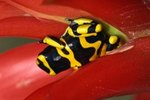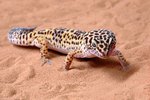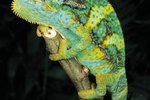“Holes,” Louis Sachar’s Newbery Medal and National Book Award-winning novel, features yellow-spotted lizards. These highly venomous reptiles live in holes in the desert. While their names are similar, though, these fictitious lizards have almost nothing in common with the shy, elusive yellow-spotted night lizards of Central America. These reptiles inhabit rain forests throughout Central America. They spend their lives concealed in damp areas that have plenty of insects and other prey. They're usually shy but can become fierce when people try to handle them. Because these lizards are so reclusive, scientists don’t have reliable population numbers.
Description
As their name indicates, these reptiles have black or dark brown backs spotted with yellow. Their bellies also are yellow, usually with brown patches. As adults, they measure between 2 1/2 and 5 inches long.
Habitat
Yellow-spotted night lizards live in the subtropical and tropical rain forests of Central America. They’re found along both the Atlantic and the Pacific coasts and at elevations up to 2,265 feet. Temperatures in their home ranges average between 71 and 86 degrees Fahrenheit, and humidity usually remains from 70 to 85 percent.
Microhabitat
Yellow-spotted night lizards are microhabitat specialists, which means they remain in or near the same spot throughout their lives. They’re often found in decaying logs or under leaf litter on the forest floor, but some also live beneath rocks or in crevices. Their flat heads and bodies help them squeeze into narrow cracks.
Food
Ants, centipedes, flies, scorpions and spiders make up most of the lizards’ diet. While they often find prey without leaving their microhabitat, yellow-spotted night lizards can emerge to hunt, if necessary.
Reproduction
Because these lizards remain in their microhabitats, populations tend to be isolated. Fortunately, they don’t have to venture out to find mates; most yellow-spotted night lizards are females who reproduce through parthenogenesis -- their eggs develop without being fertilized. Some populations include males, and in those cases, the lizards reproduce sexually. In either case, the young are born alive rather than hatched from eggs.
References
- Encyclopedia of Life: Lepidophyma flavimaculatum -- Yellow-spotted Night Lizard
- Davidson College: Biology at Davidson: Herp Expedition to Tortuguero, Costa Rica: Lepidophyma flavimaculatum
- University of Texas at Austin: Digimorph: Lepidophyma flavimaculatum, Yellow-spotted Night Lizard: Jessie Maisano
- Reptile Rescue Orange County: Yellow Spotted Night Lizard (Lepidophyma flavimaculatum): John F. Taylor
- Holes: Louis Sachar (PDF)
- Louis Sachar




